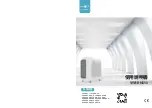
10
Acoustical Duct Work — Certain installations
may require the use of acoustical lining inside
the supply duct work. Acoustical insulation must
be in accordance with the current revision of the
Sheet Metal and Air Conditioning Contractors
National Association (SMACNA) application
standard for duct liners. Duct lining must be UL
classified batts or blankets with a fire hazard
classification of FHC-25/50 or less. Fiber duct
work may be used in place of internal duct liners
if the fiber duct work is in accordance with the
current revision of the SMACNA construction
standard on fibrous glass ducts. Fibrous duct
work and internal acoustical lining must be NFPA
Class 1 air ducts when tested per UL Standard
181 for Class 1 ducts.
Horizontal to Down flow Conversion — The unit
is shipped ready for horizontal duct connections.
If down flow ducts are required, the unit must be
converted following the steps below for both the
supply and return ducts.
1) Remove the horizontal duct cap.
2) Locate the duct cap inside the duct
openings and remove the screw holding
it in place.
3) Lift the cap out of the unit. (The cap can
be pushed up from the bottom by reaching
through the fork slot).
4) Cover the horizontal duct opening with the
horizontal duct cap. The insulation will be
on the indoor side.
5) Fasten the cover with screws to seal.
Clearance — These units are approved for 0
inch clearance.
ElECTRICAl WIRINg
general — Electrical power wiring must be made
in accordance with all applicable local codes and
ordinances, and with the current revision of the
National Electric Code NFPA 70 or in Canada
CSA C.22.1 - Canadian Electrical Code Part 1.
If any of the original wire as supplied with the
unit must be replaced, it must be replaced with
material of the same gage and temperature
rating.
WARNINg:
To avoid the risk of electrical shock,
personal injury, or death, disconnect
all electrical power to the unit before
performing any maintenance or
service. The unit may have more than
one electrical power supply.
line Voltage — Before proceeding with the
electrical connections, make certain that the
voltage, frequency, and phase of the supply
source are the same as those specified on the unit
rating plate. Also verify that the service provided
by the utility is sufficient to handle the additional
load imposed by this equipment.
See the unit wiring label for proper high and low
voltage wiring. Make all electrical connections
in accordance with all applicable codes and
ordinances.
Use a separate branch electrical circuit for this
unit. A means of electrical disconnect must be
located within sight of and readily accessibility
to the unit. Internally mounted circuit breakers
are available as field installed options. These
circuit breakers can be used as an electrical
disconnect.
The unit is shipped from the factory wired for 240
volt transformer operation. For 208 volt operation,
remove the lead from the transformer terminal
marked 240V and connect it to the terminal
marked 208V. For maximum ampacity and over
current protection, see the unit rating plate.
Provide power supply (or supplies) for the unit in
accordance with the unit wiring diagram, and the
unit rating plate. Connect the line-voltage leads
to the corresponding terminals on the contactor
(or the circuit breaker when the field installed
circuit breaker kits are used) inside the control
compartment. Use only copper wire for the line
voltage power supply to this unit. Use proper code
agency listed conduit and a conduit connector
for connecting the supply wires to the unit and
for obtaining proper grounding. Grounding may
also be accomplished by using the grounding
lug provided in the control box.
Содержание Q4SE-X24/PPH1SE
Страница 2: ...2...










































